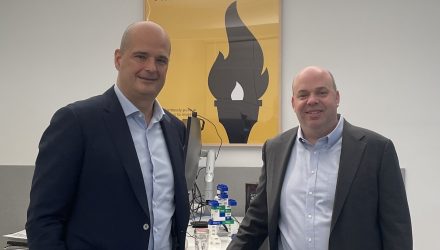The U.S. ETF industry continues to evolve. In the first 10 months of 2023, fixed income ETFs gathered more than 40% share of the net inflows, despite representing just 20% share of the market. BlackRock has seen strong demand for its fixed income products, through new money and high trading volume. However, the firm has also experienced new competition. VettaFi sat down in November with Dominik Rohe, head of BlackRock’s Americas ETF and Index Investments business to discuss these developments. All data was as of the end of October 2023. With so much ground covered, the interview is being published as two articles. Read part two on this website.
VettaFi: What are some of the areas where BlackRock saw strong ETF demand this year regarding net inflows and/or high trading volume?
Rohe: Higher-for-longer interest rates globally have seen investors reposition portfolios and allocate to fixed income. While fixed income investors have a range of vehicle choices, the desire for transparency, access, liquidity, and efficiency is leading investors to turn to bond ETFs to access the fixed income markets. In the U.S, iShares has seen $55 billion in bond ETF flows through October 2023, largely driven by our U.S. Treasury ($36 billion) and multisector ($16 billion) exposures.
The iShares 20+ Year Treasury ETF (TLT) is the leading inflow ticker for the bond ETF industry and No. 3 across all ETFs, with $20 billion of inflows year to date. Despite the rising rate environment, potential reasons for continued buying include investors’ flight to quality amid recessionary fears and anticipation of normalized yields on the long end.
TLT has also seen inflows driven by long-term asset allocation decisions and investors “barbelling” their Treasury allocation pairing both short and long duration exposures. Throughout the year, TLT has experienced elevated trading, with a year-to-date average daily volume of $2.6 billion. Trading peaked on October 19, with $7.3 billion traded on the day. This was the third largest trading day ever for the fund.
As for multisector exposures, the iShares Core U.S. Aggregate Bond ETF (AGG), which turned 20 years old this September, has seen over $11 billion of inflows as investors have rotated back into core fixed income to take advantage of the rise in yields.
We are also seeing institutional investors look to iShares for tactical asset allocation. The iShares High Yield Corporate Bond ETF (HYG) recorded its highest trading day since inception, with over $10 billion traded on October 4, even while the fund saw outflows.
VettaFi: Those three were some of the first fixed income ETFs in the U.S. What’s happening with some of the newer products?
Rohe: We have also seen significant interest from investors in our BuyWrites and iBonds suites as they search for yield. We have an iShares BuyWrites suite that includes the iShares 20+ Year Treasury Bond BuyWrite Strategy (TLTW), the iShares Investment Grade Corporate Bond BuyWrite Strategy ETF (LQDW), and the iShares High Yield Corporate Bond BuyWrite Strategy ETF (HYGW).
This is a remarkable example of the impact bond ETFs have had in enabling innovation, taking an equity market structure, and applying it to fixed income. These funds are resonating with investors looking for enhanced income, seeing $953 million in flows on a year-to-date basis and reaching over $867 million in AUM since their debut in August 2022. The funds offer income from two different sources, including the premiums resulting from the sale of the monthly call options and the income generated by the underlying bond ETFs.
In addition, we continue to see investors turn to iShares iBonds as clients look to lock in yields in a more convenient way. We have seen $7 billion in inflows on a YTD basis, with $25 billion in assets across the entire suite. Advisors are gravitating to iBonds to build and maintain bond ladders and to better scale their practice. (Editor’s note: The iShares iBonds Dec 2032 Term Corporate Bond ETF (IBDX) is an example.)
VettaFi: How about the equity side of the ETF universe? Where have you seen success?
Rohe: We have also seen significant interest in our Core Equity suite, which has reached $40 billion in flows on a year-to-date basis, primarily driven by the iShares Core S&P 500 ETF (IVV). Our Single Factor strategies have also been a bright spot, adding $8 billion. This was largely driven by the iShares MSCI USA Quality Factor ETF (QUAL).
VettaFi: Given the strong demand in ETFs in recent years, but also the growing supply of products and asset managers, are you worried there’s no longer room for growth?
Rohe: A question we constantly pose to ourselves is, how much choice do investors need? Our clients are asking us for even more high-quality ETFs that provide even more granular access to every corner of the market. Our high-quality standards assess our ETFs’ ability to offer liquidity, price discovery, and efficient access to markets in all market conditions.
It is important to remember that ETFs remain a fraction of the total U.S. financial market in both equities and fixed income, representing 12.7% of equity assets and just 2.6% of fixed income assets.
For more news, information, and strategy, visit ETF Trends.


